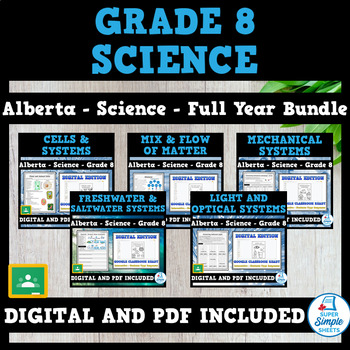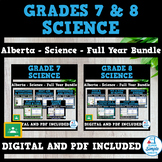Alberta - Grade 8 Science - FULL YEAR BUNDLE
- Zip
- Google Apps™

What educators are saying
Products in this Bundle (5)
Also included in
- GOOGLE AND PDF VERSIONS BOTH INCLUDED! PERFECT FOR A SPLIT GRADE CLASS!This bundle covers all expectations in the Alberta Grades 7 & 8 Science Curriculums. These massive units contains readings, diagrams, experiments, true/false, and much more!Most importantly, we have made cross-curriculum connPrice $60.00Original Price $80.00Save $20.00
Description
GOOGLE AND PDF VERSIONS BOTH INCLUDED!
This bundle covers all expectations in the Alberta Grade 8 Science Curriculum.
These massive units contains readings, diagrams, experiments, true/false, and much more!
Most importantly, we have made cross-curriculum connections to the grade 8 language program. Students will practice reading comprehension strategies (making connections, questioning, visualizing, and inferencing) as they work through this unit.
Check out the previews of these units to learn more about how it can benefit your students. We know you will love this no-prep, just print or upload to Google, time-saving resource!
Mix of Flow and Matter
Some of the concepts that are covered:
- What is a fluid?
- WHMIS – Understanding safety symbols
- The safe handling, disposal, and storing of fluids
- Pure substances – compounds and elements
- Mixtures and pure substances
- Homogenous mixtures and heterogenous mixtures
- Classifying mixtures and pure substances
- Classifying homogenous and heterogenous mixtures
- Science experiment – homogenous and heterogenous mixtures
- Solutes, solvents, and solutions
- Science experiment – testing the dissolving process
- Factors affecting solubility
- Describing solutions – concentration and dilution of solutions
- Describing the concentration of solutions – in quantitative and qualitative terms
- Understanding viscosity
- Experiment – comparing viscosities
- Particle theory – effects on fluids
- Relationship between mass, volume, and density
- Density of gases, liquids, and solids
- Calculating density – mass/volume
- Buoyancy – positive buoyancy, negative buoyancy, and neutral buoyancy
- Experiments determining buoyancy – water vs saltwater vs sugar water
- Archimedes’ Principle
- Lighter-than-air flying devices – airships and hot air balloons (buoyancy of gases)
- Compressing gases – experiment and reading/questions
- Mishandling of compressed gases
- Hydraulic systems vs pneumatic systems
- Pascal’s Law – buoyancy
- Performing calculations using Pascal’s Law
- Factors affecting the flow of fluids – temperature, pressure, density, viscosity
- Calculating pressure – force per unit of area (Newtons per metre squared, Pascals, Kilopascals, and PSI)
- Regulating fluids in the circulatory system and in engines
- Valves in mechanical systems
- Comparing a fish’s bladder vs ballast water
- Impacts of fluid technologies – renewable energy (wind turbines, hydro)
- Oil spills - The Deepwater Horizon oil spill
- Indigenous communities and oil spills – Ocean Man oil spill
- Hands on Experiments – Comparing viscosities, densities of liquids, buoyancy, air pressure
- Building a hydraulic system
- Reading and writing code – cleaning up oil spills and coding hydraulic systems
- STEM Assignment – Researching and inventing fluid technologies
- Unit test
- Answer pages for all activities
Cells and Systems
Some of the concepts that are covered:
- What is a cell?
- Cell theory
- Organelles in cells – nucleus, cell membrane, cytoplasm, cell wall, mitochondria and more
- Research assignment – organelle in plant and animal cells
- Diagrams of plant and animal cells
- Comparing plant and animal cells – structure, organelles, size, shape
- Identifying plant and animal cells
- Experiment/activity – building a 3D model of a cell
- Diffusion of molecules in cells
- Osmosis in cells
- Factors affecting diffusion
- Diffusion and the exchange of gas in humans and frogs
- Ideal solutions for cells – osmosis
- Unicellular organisms – Amoeba and Paramecium
- Research assignment – studying unicellular organisms
- Multicellular organisms – humans, worms, and frogs
- Levels of organization – cells, tissues, organs, and organ systems
- Researching organ systems to learn about the organs, tissues, and cells included
- Nervous system – diagrams, reading and questions
- Circulatory system – diagrams, reading and questions
- Circulatory system experiment – testing heart rate and exercise
- Respiratory system – diagrams, reading, questions, and building a respiratory system model
- Digestive system – diagrams, reading, questions, and creating a model digestive system
- Skeletal system - diagrams, reading and questions
- Muscular system - diagrams, reading and questions
- Integumentary system – reading, diagram, and questions
- Immune system – reading, diagram, and questions
- Excretory system – reading, diagram, and questions
- Diseases – Stroke, Asthma, Celiac, and Epilepsy – Readings and questions for all four
- Stem cell technologies treating disease – Alzheimer's and Spinal injuries
- Researching advantages and disadvantages of stem cells
- Cellular agriculture – cultured meat
- Using cultured meats – multiple perspectives (animals, environmentalists, livestock farmers)
- Unit test
- Answer pages for all activities
Light and Optical Systems
Some of the concepts that are covered:
- What is light?
- Properties of light – light absorbing, light reflecting, and light refracting
- Experiment – light maze
- Measuring reflected light using diagrams and a protractor
- White light – seeing colours
- Light interacting with different materials – absorbing, reflecting, and refracting
- STEM Assignment – creating a soundproof room
- Experiment – creating a soundproof box
- Light transmission - transparent, translucent, and opaque materials
- Experiment – transparent, translucent, and opaque materials
- Light refraction – reading and questions
- Experiment – demonstrating refraction
- Experiment – refraction in water versus saltwater
- Refraction – measuring angles of incidence and angle of refraction
- Optical illusions
- Research - Mirages and Rainbows
- Coherent versus incoherent light
- Vision – how do our eyes work?
- Binocular vision and binocular vision dysfunction (lazy eye, crossed eyes, etc.)
- Cones and rods
- Comparing eyes and cameras
- Concave versus convex lenses
- Microscopes – compound lenses
- Microscope diagram
- Electron microscope
- Devices that use light – telescope, microscope, motion detector, microwaves, traffic lights
- Light technologies – lasers correcting eye impairments
- LASIK and cataract surgery
- Optical systems in animals
- Unit test
- Answer pages for all activities
Mechanical Systems
Some of the concepts that are covered:
- What is a system?
- Purpose, inputs, and outputs of systems
- Components of systems – computer system, HVAC system, and backhoe system
- Improving mechanical systems over time – Mill wheel, Archimedes’ Screw, Persian Wheel
- Trial and error – The Wright Brothers and their experimenting/success in building a flying machine
- Physics – using scientific terms (energy, work, forces, displacement, efficiency)
- Different types of energy – chemical, electrical, thermal, mechanical, nuclear
- Forces – contact and non-contact forces
- Research assignment – understanding the compass
- Describing everyday situations using scientific terms – forces, energy, work, displacement, efficiency
- Calculating work using the formula work = force x distance
- Mechanical advantages using simple machines
- Calculating the mechanical advantages of levers, gears, pulleys and inclined planes
- Diagrams of the simple machines and their mechanical advantages
- Lever experiment
- Compound machines – combining simple machines to build powerful systems
- Analyzing compound machines and systems
- Pneumatic systems – pressurized air (air compressor and nail guns)
- Hydraulic systems – qualitative and quantitative descriptions of the system
- Determining the mechanical advantages of hydraulic systems
- Pressure of fluids
- Importance of machines – Machines helping us build the structures we have now
- Calculating the pressure of pneumatic and hydraulic systems – Pascals and Kilopascals
- Dissipating heat from mechanical systems
- Friction causing dissipation (sliding friction, static friction, and rolling friction)
- Technologies reducing friction and dissipation (lubricants, wheels, furniture sliders)
- Experiment – phone book friction (sticky notes)
- Calculating efficiency – energy out/total energy in = efficiency
- Technological innovations improving productivity – robotics, artificial intelligence (AI), 3D printing
- Research assignment – Industry 4.0 (evolution of industrial revolution)
- Automation of manufacturing industry
- Impact of automation on society, economy, and the environment
- Self-driving autonomous vehicles
- Automation – different points of view
- Hands on experiments – testing machines and testing efficiency
- Building models, systems, or structures
- Reading and writing code – self-driving vehicles, lawn mowers, robot vacuums
- Unit test
- Answer pages for all activities
Freshwater and Saltwater Systems
Some of the concepts that are covered:
- Studying glaciers – the Cryosphere
- Water distribution on Earth
- Water characteristics
- TDS – Total dissolved solids found in water
- Difference between freshwater, saltwater, and potable water
- Plants and animals living in saltwater and freshwater
- Ocean depth zones
- Animals living at each ocean depth
- Aquatic habitats – deep ocean
- Overfishing – effects on populations
- Watershed, Water table and Aquifers
- Groundwater diagrams
- Coastal erosion – headlands, sea stumps, sea caves, sea stacks, arches
- Formation of headlands and bays
- Meandering streams – erosion and deposition
- Experiment - flow rate of a stream
- Oceanic basins – geological features (trenches, continental shelves, and submarine volcanoes)
- Drinking water – Different types of wells
- Human activities affecting the water table
- Climate change – Melting glaciers
- Effects of melting glaciers on coastal communities
- Assignment – Creating an Infographic about Melting Glaciers
- Coastal Storms – Hurricanes, Typhoons, Cyclones as well as storm surges and flooding
- Microclimates – Victoria, BC
- Comparing atmospheric conditions in coastal regions versus regions inland
- Water quality – pH levels, turbidity, bacteria, dissolved oxygen
- Experiment – determining pH levels in local bodies of water
- Human activities affecting water quality – agriculture, fossil fuels, sewage, pharmaceuticals
- Water treatment plants – research assignment and reading/questions
- Tertiary water treatment systems
- Rural water treatment systems – Septic tanks
- Experiment – creating a water filter
- How cities manage water – water meters and incentives to conserve water usage
- Personal water consumption survey
- How the Indigenous use water
- Drinking water advisories in First Nation communities
- Rainwater harvesting and greywater systems - technologies
- Desalination systems – converting saltwater to freshwater technologies
- Hands on Experiments – groundwater model, testing pH levels, making a water filter, finding a microclimate
- Reading and writing code – water testing technology and water testing invention
- Unit test
- Answer pages for all activities
This is a comprehensive bundle that will save you hours of planning! It has been tested and found effective in helping students achieve the learning goals in the science curriculum.
Follow Super Simple Sheets for more resources like this one!



